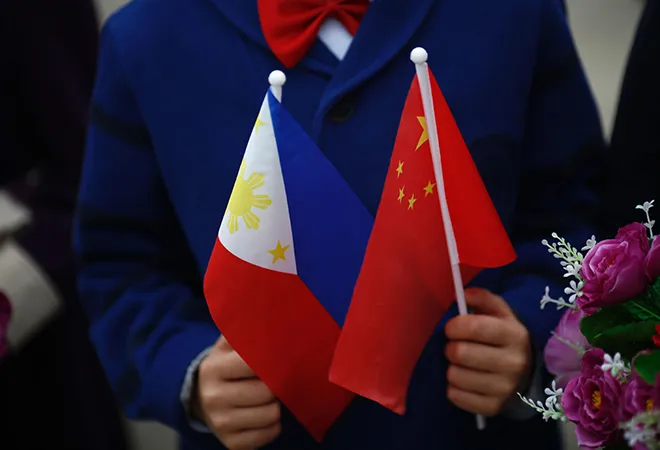 This is the 125th article in the series –
This is the 125th article in the series – The China Chronicles.
Read the articles here.
The Philippines’ China policy has been a rocky ride. When the current President of the Philippines, Duterte, had come to power in 2016, there was a notable shift visible in the Philippines’ foreign policy with regard to the United States (US) and China. The former President, Benigno Aquino III, had embarked on a policy of cosying up to the US, the Philippines’ erstwhile treaty ally. He actively resisted Chinese encroachments on Philippine sovereignty and bid for the Permanent Court of Arbitration (PCA) to dismiss China’s “nine-dash line” claim in the South China Sea. In contrast, when Duterte had come to power, he only focused on jumping on the Chinese bandwagon, even sometimes going as far as
declaring China as the Philippines’ ally. The hope was China would ease on its aggression towards the Philippines in the South China Sea and also contribute heavily towards the economic and infrastructure development of the Philippines, especially President Duterte’s own ‘Build Build Build’ initiative. But in the recent months, it seems this friendly and accommodative policy towards China has been done away with and there has been a resumption of efforts to again align with the United States. What has led to this shift in Duterte’s China policy? How is the current unison with the United States shaping up? Does this shift in the attitude towards China mark the beginning of missteps and stumbles in China’s neighbourhood policy particularly with regard to Southeast Asia?
In recent months, Manila is being seen to fully reinstate its security ties and rebuild trust with Washington in a desperate attempt to deter Beijing. This is reflective in the series of high-level visits; the restoration of wide-ranging defence agreements, with Manila being one of the few Southeast Asia countries to
completely endorse the AUKUS security pact between Australia, Britain, and the United States; the
re-establishment of the Philippines-United States Bilateral Strategic Dialogue; the plan to
return to full scale military drills (Balikatan exercises) in 2022 and also alongside invite Australia and UK as observers. The most notable step was when in July 2021 during the visit of the US Secretary of Defence, Lloyd Austin, to Manila, Duterte
called off his objections on terminating the age-old Visiting Forces Agreement (VFA) with the United States and restored the agreement. Additionally, in July 2020, he finally authorised the Philippines’ Department of Foreign Affairs to notify China to recognise the 2016 ruling by the Permanent Court of Arbitration in The Hague that rejected Beijing’s claims to disputed waters. Duterte went from opting to remain silent with regard to the 2016 PCA ruling in an attempt to cosy up to China, to last year making a
statement in the United Nations General Assembly, “that the 2016 ruling in favour of the Philippines was “beyond compromise” and that any attempts to undermine it would be rejected.” All this clearly shows that the China-friendly policy has been kept at bay for the time being and the United States is again the new found support.
Reconsidering its China-friendly policy
The reason for this shift in the China policy can mainly be attributed to the fact that there was hardly any change in the Chinese attitude, especially with regard to its incursions in the disputed waters of the South China Sea and also the massive investments that Duterte was promised under the Belt and Road Initiative (BRI) has also hardly materialised. The
only two notable BRI projects in the Philippines are small: One involves a couple of bridges in Manila and the other, a controversial dam, which could seriously harm a nature preserve. China has also beefed up its South China Sea operations. In 2019 and 2020, China
encircled the Philippines’ Thitu Island (also known as Pag-asa) with hundreds of militia boats, apparently to prevent Philippine authorities from upgrading the island’s runway and making other infrastructure improvements. Then again in 2021, hundreds of Chinese fishing boats were spotted at several South China Sea islets, the most prominent being the Whitsun Reef, within the Philippines’ Exclusive Economic Zone (EEZ). It was suspected by the Philippines that these fishing boats were actually vessels from the Chinese maritime militia being sent with the motive of permanently occupying the reef. In response, the Philippines had also dispatched navy and coast guard ships to the area. In other words, Duterte’s expectations from China were not met and he has very little positives to show from his favourable China policy.
The decision for the resumption of full scale military exercises from 2022 was announced immediately after the unveiling of the AUKUS security partnership. While majority of the countries in Southeast Asia stated that this would lead to a regional arms race, the Philippines came up in full support of this security pact and
commented that Manila favours good defence ties with all countries in the Indo-Pacific. The United States is not only committed to stand with the Philippines in times of crises, but has also
allocated US $12.5 million to implement a deal that allows American projects in Philippine military bases. For the United States, access to Philippines military bases is vital for deterring the growing Chinese aggression not only in the South China Sea, but also in Asia like in the Taiwan Strait. In an attempt to deal with the growing China challenge, Duterte has, indeed, amped up his engagement with the United States. In late August 2021, the commander of U.S. Indo-Pacific Command, Adm. John Aquilino,
visited the Philippines to further strengthen the alliance. In September 2021, Philippine Secretary of Foreign Affairs, Teodoro L. Locsin Jr, and Secretary of National Defense, Delfin Lorenzana,
visited Washington to meet with their counterparts and celebrate the 70th anniversary of the establishment of the US-Philippines Mutual Defense Treaty. Of significance is the
implementation of the Enhanced Defence Cooperation Agreement (EDCA). This was signed in 2014, but was unofficially halted by Duterte in 2016. The EDCA
allows the US military to construct facilities and preposition defense assets inside Philippine military bases. These bases are the Antonio Bautista Air Base, Basa Air Base, Fort Magsaysay, Lumbia Air Base, and Mactan-Benito Ebuen Air Base.
The United States is not only committed to stand with the Philippines in times of crises, but has also allocated US $12.5 million to implement a deal that allows American projects in Philippine military bases.
China’s continuous encroachments in the disputed islands and waters of the South China Sea has led to the rethinking and redesigning of many of its Southeast Asian neighbours’ China policy. The most noteworthy in this regard is the case of the Philippines. A long-time ally of the United States, when President Duterte took over office, a shift in approach by concentrating on ways to showcase a strong alignment towards China was the main facet of his foreign policy. Completely shunning the United States and thinking of scrapping age-old security pacts did raise a lot of concern in the Philippines, but Duterte seemed set in his ways. This marked change in the China policy does raise strong questions on the feasibility of the Chinese neighbourhood policy in Southeast Asia. Will the BRI projects in this region be enough to keep the ASEAN countries from aligning with the US and the other like-minded countries of the Indo-Pacific? Economic diplomacy has indeed been a strong weapon for China to manipulate its way in the functioning of the ASEAN and also to make a stronghold in this region, but with the BRI projects not bearing as much fruit and the investments not being on a par with the expectations of the regional leaders, China will need to rethink and remap its Southeast Asia policy. The Philippines case does present a strong hint in that direction.
In October 2021, President Duterte announced his retirement from politics which took most by surprise and raised speculations that he is clearing the way for a presidential run for his daughter, Sara Duterte-Carpio, who is currently the mayor of Davao city in the Philippines. The question that arises is under a new government will there be a shift in the Philippines’ China policy? Duterte had started off with a China-friendly policy, unlike the former Presidents and also by going against the public opinion in the Philippines. The Filipinos, over the years, have grown to completely distrust China and still rest their full faith on the United States. There are six candidates
contesting for Presidency—Senator Ronald dela Rosa, Ferdinand “Bongbong” Marcos Jr., Vice President Leni Robredo, Senator Panfilo Lacson, Manila Mayor Francisco Moreno, and Senator Manny Pacquiao. While it is being perceived that Senator Rosa and Marcos Jr. might still believe in a pro-China policy as they too echoed Duterte’s sentiments that investments and trade from China is the need of the hour. The other candidates have always raised strong objections to Duterte’s pro-China policy, his complete disregard for the 2016 PCA ruling just for drawing economic gains from China. Given that the economic benefits that was assured from the Chinese end have not been met, but the aggressive posturing in the disputed waters of the South China Sea has aggravated, it seems only logical for the new government to revert to courting the United States and also the other like-minded countries of the Indo-Pacific like Japan, Australia, India amongst others.
The views expressed above belong to the author(s). ORF research and analyses now available on Telegram! Click here to access our curated content — blogs, longforms and interviews.



 This is the 125th article in the series – The China Chronicles.
Read the articles
This is the 125th article in the series – The China Chronicles.
Read the articles  PREV
PREV


